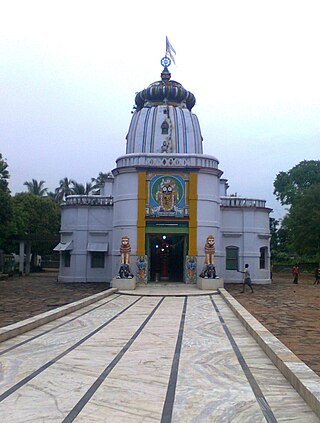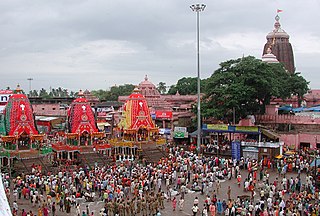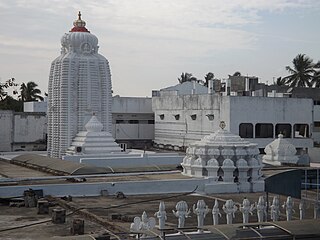
Jagannatha is a deity worshipped in regional Hindu traditions in India as part of a triad along with his (Krishna's) brother Balabhadra, and sister, Subhadra. Jagannath, within Odia Hinduism, is the supreme god, Purushottama, and the Para Brahman. To most Vaishnava Hindus, particularly the Krishnaites, Jagannath is an abstract representation of Krishna, sometimes as the avatar of Vishnu. To some Shaiva and Shakta Hindus, he is a symmetry-filled tantric form of Bhairava, a fierce manifestation of Shiva associated with annihilation.

Puri is a coastal city and a municipality in the state of Odisha in eastern India. It is the district headquarters of Puri district and is situated on the Bay of Bengal, 60 kilometres (37 mi) south of the state capital of Bhubaneswar. It is home to the 12th-century Jagannath Temple and is one of the original Char Dham pilgrimage sites for Hindus.

Shri Jagannath temple(Odia: ଶ୍ରୀ ଜଗନ୍ନାଥ ମନ୍ଦିର) is a temple located in Koraput, Odisha, India. It is not only built as an altar for worship, but also as a multipurpose area for Jagannath consciousness. Jagannath consciousness is the main theme of Jagannath which can not be confined within the limits of a traditional religious theological order, because it is a cult.

Puri district is a coastal district of the Odisha state of India. It has one sub-division, 11 tahasils and 11 blocks and comprises 1722 revenue villages. Puri is the only municipality of the district. Konark, Pipili, Satyabadi, Gop, Kakatpur and Nimapada are the NACs in this district while Brahmagiri being a semi-urban town.

Nayagarh is both a town and the municipality headquarters of the Nayagarh district in the Indian state of Odisha.

The Jagannath Temple is a Hindu temple dedicated to the god Jagannath, a form of Vishnu in Hinduism. It is located in Puri in the state of Odisha, situated on the eastern coast of India. As per temple records, King Indradyumna of Avanti built the main temple of Jagannath at Puri. The present temple was rebuilt from the tenth century onwards, on the site of the pre-existing temples in the compound, but not the main Jagannath temple, and begun by Anantavarman Chodaganga, the first king of the Eastern Ganga dynasty. Many of the temple rituals are based on Oddiyana Tantras which are the refined versions of Mahayana Tantras as well as Shabari Tantras which are evolved from Tantric Buddhism and tribal beliefs respectively. The local legends link the idols with aboriginal tribes and the daitapatis (servitors) claim to be descendants of the aboriginals. The temple is one of the 108 Abhimana Kshethram of the Vaishnavite tradition.

Lingaraja Temple is a Hindu temple dedicated to Shiva and is one of the oldest temples in Bhubaneswar, the capital of the Indian state of Odisha, India. The temple is the most prominent landmark of Bhubaneswar city and one of the major tourist attractions of the state.

The Rathayatra of Mahesh is the oldest chariot festival in Bengal, and is said to have been celebrated since 1396. The first temple of Jagannath Deb was built by Raja Manohar Roy of Sheoraphuli Raj who also denoted large portion of land in establishing the Jagganathpur Mouza. It is held in Mahesh, a historical locality within Serampore in the Indian state of West Bengal. It is a week-long festival and a grand fair is held at that time. People throng to have a share in pulling the long ropes (Rosshi) attached to the chariots of Lord Jagannath, Balarama and Subhadra on the journey from the temple to Mahesh Gundicha Bari and back within 8th day.
Odisha is one of the 28 states of India, located on the eastern coast. It is surrounded by the states of West Bengal to the northeast, Jharkhand to the north, Chhattisgarh to the west and northwest, and Andhra Pradesh to the south and southwest. Odia is the official and most widely spoken language, spoken by 33.2 million according to the 2001 Census. The modern state of Odisha was established on 1 April 1936, as a province in British India, and consisted predominantly of Odia-speaking regions. April 1 is celebrated as Odisha Day.

Gundicha Temple, is a Hindu temple, situated in the temple town of Puri in the state of Odisha, India. It is significant for being the destination of the celebrated annual Rath Yatra of Puri. While it remains vacant most of the year, the temple is occupied by images of the deities of Jagannath, his brother Balabhadra and sister Subhadra for seven complete days every year during the annual Rath Yatra festival.

The Char Dham, also rendered the Chatur Dhama is a set of four Hindu pilgrimage sites in India, consisting of Badrinath, Dwarka, Puri and Rameswaram. Badrinath, Dwarka, and Puri are shrines of Vishnu, whereas Rameswaram is a shrine of Shiva.

Sri Nilamadhava Temple is very old and famous Lord Vishnu temple which is near to the bank of Mahanadi, in Kantilo, Odisha, India. It is present near to the twin hills with a surrounding forest. A permanent flow of holy water from the feet of Lord Nilamadhava is another attraction of the spot. Lord Siddheswar is also present which is another highlight of the place.

Raj-Ranpur is a town and a Notified Area Council in the district of Nayagarh in the eastern Indian state of Odisha. The town is also known as Ranpurgarh or simply Ranpur as per the modern usage. The town is historically significant especially during the British Raj when it was the capital of the princely state of Ranpur. The martyrs Shaheed Raghu-Dibakar who were hanged for their resistance to British rule belong to this place. Rajsunakhala and Tangi are the nearest Town of Raj-Ranpur, which in almost 10 to 20 km from the town. Rajsunakhala is the most important business centre in Ranpur block under Nayagarh district.

The Kaḷinga architectural style is a style of Hindu architecture which flourished in the ancient Kalinga previously known as Utkal and in present eastern Indian state of Odisha. The style consists of three distinct types of temples: Rekha Deula, Pidha Deula and Khakhara Deula. The former two are associated with Vishnu, Surya and Shiva temples while the third is mainly with Chamunda and Durga temples. The Rekha Deula and Khakhara Deula houses are the sanctum sanctorum while the Pidha Deula constitutes outer dancing and offering halls.

Shri Shri Hari Baladev Jew Bije is a famous Hindu temple located in Baripada, Mayurbhanj district, in the state of Odisha, India. The name Jagannath is a combination of the Sanskrit words Jagat (Universe) and Nath.
Itamati is a village located in Nayagarh district of Odisha, India. It is 6 km from Nayagarh Town. Itamati is known as the major business centre of Nayagarh, Also known as the second largest village of Odisha.

Ratha Yatra, or chariot festival, is any public procession in a chariot. They are held annually during festivals in India, Nepal and Sri Lanka. The term also refers to the popular annual Ratha Yatra of Puri. that involve a public procession with a chariot with deities Jagannath, Balabhadra, Subhadra and Sudarshana Chakra on a ratha, a wooden deula-shaped chariot.

Narasinghpur is a town and Notified Area Council in Cuttack district in the Indian state of Odisha.

Arasavalli Sun Temple is a temple for Lord Surya, the solar deity, at Arasavalli in the Indian state of Andhra Pradesh. It is located in Arasavalli Village 1 km east of Srikakulam. It is believed that the temple was built in 7th century CE by King Devendra Varma, a great ruler of Eastern Ganga Dynasty of Kalinga. The present structure is largely a result of 18th-century renovations. The temple was built in Rekha deula style of Kalinga Architecture like Puri Jagannath temple of Odisha. This temple is considered one of the oldest sun temples in India. The temple is one of the two major temples who worship Lord Surya in India. The other two are the Konark Sun Temple, Odisha and Martand Sun Temple, Jammu and Kashmir.



















